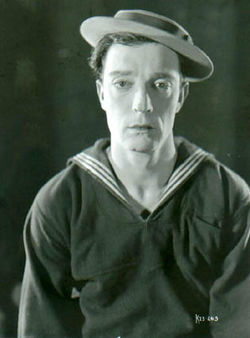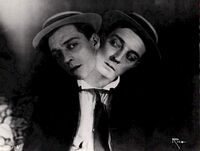Buster Keaton
Joseph Frank "Buster" Keaton (October 4, 1895 – February 1, 1966) was a unique and talented comedic actor during the silent film era. Most recognized in America, he was also known throughout the world as "the other silent movie guy who isn't Charlie Chaplin".
Pre-acting career (Unimportant years – feel free to skip this.)
Buster Keaton was born in 1895, and was like most people of that time: unfunny, proper and boring, even though his parents were stage performers. Having a baby didn't cramp their style. They just tied the youngster to a support beam or stuck him in a trunk offstage to keep him out of the way while they performed, until the day he lost the end of his finger in a wash wringer accident. When Joe and Myra found out that paying a doctor to amputate the end of Buster's crushed finger was even more expensive than paying for a babysitter would have been been, they decided to just incorporate him into the act. That way he'd be on stage so they could injure him themselves, rather than leaving his injuries purely to chance. Besides, now his injuries would be covered by workmen's comp.
The act was highly sophisticated for the time: Myra would play the saxophone while Joe would hurl Buster around, using a suitcase handle sewn into the kid's clothes. Up until The Three Keatons, most of rural America was relying on quilting bees and barn raisings for entertainment; musical child abuse was a refreshing change. The addition of Buster to the act allowed the Keatons to move out of the total obscurity of third-rate medicine shows to the near-total obscurity of bottom-rung vaudeville. No longer was Joe Keaton just The Man with a Table – he was The Man with a Table, a Wife, and an Annoying Kid.
Young Buster – so named because he fell down the stairs as a baby – attracted the attention of the Society for the Prevention of Stage Parenting, who tried to close down the act because it wasn't right to let young children perform on stage; they were needed in the sweatshops. Joe responded that since Buster never actually moved under his own power he wasn't a performer, he was a prop. The SPSP successfully argued in court that since he was alive (in spite of his father hurling him headfirst into a brick wall), Buster was a performer, not a prop, and drove the Keatons out of New York, forcing them to settle for hurling Buster in cheap venues in flyover states until the kid turned 14 and was thus old enough for his parents to pretend he was 16. Once Buster could pass for 16, the SPSP had no further problems with Joe hurling him into the orchestra pit, on the grounds that as a snotty teenager he probably deserved it.
Finally, at age 21, Buster got sick of the vaudeville routine of getting hurled around by his skinny-ass father. He visited Roscoe "Fatty" Arbuckle's new studio and got his first movie role: In a total departure from his vaudeville act, Buster would now get hurled around by a big fat guy.
Silent films (Okay, you should probably read this.)
Keaton's debut role in The Butcher Boy (as Kid Who Gets His Hat Stuck on His Head with Molasses) led to his role in The Rough House (as Bicycle Delivery Boy Who Gets Clotheslined). Arbuckle, feeling that his young protoge was ready for a more demanding role, cast him in His Wedding Night (as Bicycle Delivery Boy Who Goes Over the Handlebars). Keaton found this role transformative, as he cross-dressed in a wedding gown and nearly married both Arbuckle and Arbuckle's nephew, Al St. John. This led to even more versatile roles, such as in The Garage, in which Keaton plays a mechanic who is also a fireman who goes up the pole upside-down, and The Cook, in which he plays a waiter who walks like an Egyptian. Buster also expanded his comic repertoire, sometimes falling down the stairs in addition to being hurled.
Arbuckle, who didn't believe in the adage "less is more", decided that if people liked watching two reels of a fat guy flirting with pretty girls, they'd love watching six reels of a fat guy flirting with pretty girls. He took off to do feature films, leaving Buster to run the old studio. Buster made immediate changes. No longer would he be the little guy who got hurled around and fell down and smiled and laughed a lot. He'd be the little guy who got hurled around and fell down and never smiled or laughed. It was a bold gamble, but it worked.
Keaton started out making a variety of two-reelers, including Convict 13, in which he gets chased by some cops, Neighbors, in which he gets chased by some cops, and Daydreams, in which he gets chased by some cops. Ready for a change, and thinking that filmgoers were entitled to something totally new, Keaton released Cops, in which he gets chased by every cop in the world.
Having proved that he could run as well as fall and get hurled, Keaton was ready to move into feature films. His agent insisted that he star in another producer's film to gauge public reaction. This film, The Saphead, was written with an eye toward tradition, and returned to the theme of Buster being hurled. But instead of having Buster just get hurled by his skinny-ass father or his fat friend, he got hurled by the entire New York Stock Exchange. Audiences, never tiring of watching people hurl Buster Keaton, loved the film. Buster was ready to start producing his own features.
Keaton quickly rose the ranks of silent movie stars. He was best known for his stoic face and crazy physical antics, like a white version of Jackie Chan except not as cool. His films became more and more successful, as he showed his versatility in being able to fall off not only trains and buildings, but water towers as well. At age 27 Buster was the second highest paid male actor in the United States. But who was the first, you ask?
Rivalry
Despite all of Keaton's great skills and fame, Charlie Chaplin was still getting more: more attention, movie deals, money, cars, houses, promotional posters and sex! Sex! Keaton couldn't stand the fact Chaplin got more and better sex than he did, so he vowed to prove he was the better and funnier man. Chaplin had managed to cement his public persona with his signature role as the little tramp, and his movies were making so much money that he was able to make it rain on hoes regularly and often. He even had to hire a designated money thrower as his hands were hurting.
In every aspect of Keaton's life Charlie managed to one-up him. If Keaton ordered a regular sized bowl of soup Charlie would order a large. If Keaton had a girlfriend who rated a seven (maybe a weak eight) Charlie would have an eight (maybe a weak nine) girlfriend. If Keaton got a cute dog Charlie would get a cute puppy. If Keaton won a Golden Globe Award Charlie would win an Oscar. If Keaton got his own private parking space Charlie would get his own private parking lot! This constant superiority of Charlie was starting to get under Keaton's skin. Then perhaps the cow that tipped over the lamp that started the great Chicago Fire happened in late October or some month with 28 days. Charlie Chaplin during an interview with NBC radio poked fun at Keaton's crocheted scarf. Charlie was then named the king of hurtful satire. Due to Chaplin's comments Keaton's crochet sales dipped as many consumers began to believe Keaton did not sell quality crocheted products.
This didn't go well with Keaton, and thus he decided to take on Chaplin at the premiere of what would later become his most infamous film: City of Lights. Keaton arranged for his feature silent film Boise Dreams to premiere on the exact same night. Both experienced a strong turn out, but Chaplin managed to beat Keaton by a mere 1.7 million dollars at the opening box office. In terms of money today, that would equate to ... a lot of money! An article by Variety reported that Keaton had not yet proven himself against his more famous rival, and Keaton sulked away into obscurity – not making a movie for four years, which in today's terms would equate to ... a lot of years!
Final film
After a four-year hiatus, Keaton had spent almost all of his money feeding his addictive crochet habit. Finally, he decided to try and restart his career in the silent movie business, and signed onto a movie deal with Warner Brothers. The movie cost over ten million dollars to make and the company was banking on Keaton's talent to pull in interest and, ultimately, revenue for the film. But fate can be a cruel mistress, as proved by the opening night.
Buster Keaton opened up his latest movie hoping for one last run of success. That night, the movie theaters were packed – not to see Keaton's Macroeconomics: The Movie, but to see a movie by the name of The Jazz Singer, the very first movie to feature actual dialogue and sound. Nobody wanted to see Buster's mildly interesting film about an assassin who has to take on an army of darkness while simultaneously wielding only one sword, crocheting his own armor, and protecting the president's daughter (and her beloved poodle Muffins). Instead they opted to see a racist cracker singing and jiving while painted up to look like a negro.
Once again, Keaton's film was a flop, making only $500, and almost throwing Warner Brothers into bankruptcy. Had it not been for Warner Brothers' selling military secrets to the Russians, we would never have Bugs Bunny.
Final years
After the utter disaster of his final movie, nobody wanted to hire Keaton, and he was forced to retire to his small Missouri home where he practiced crocheting for the remainder of his life. He eventually crocheted a noose and hanged himself from the top of his private movie theater, which he had set up to play all his movies on a never-ending loop.
Most experts blame Keaton's suicide on the influence of Heavy Metal music. The subliminal messages in the songs of Judas Priest and Ozzy Osbourne were responsible for all suicides between 1950 and 1990, including Buster Keaton's.
Nobody is quite sure exactly when Buster Keaton died due to inflation over the years – it is known that he killed himself six years after his final movie, but that equates to at least twenty today. Dead and alone, he is now most known for almost destroying the Warner Brothers Company, and crocheting some cute mittens.



